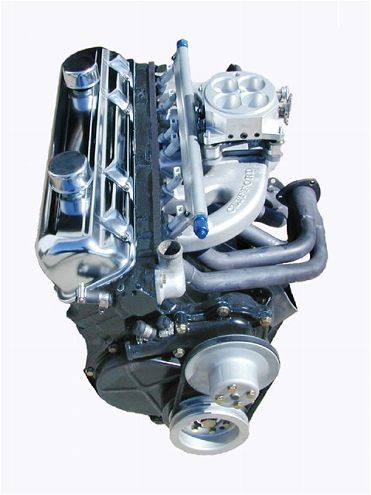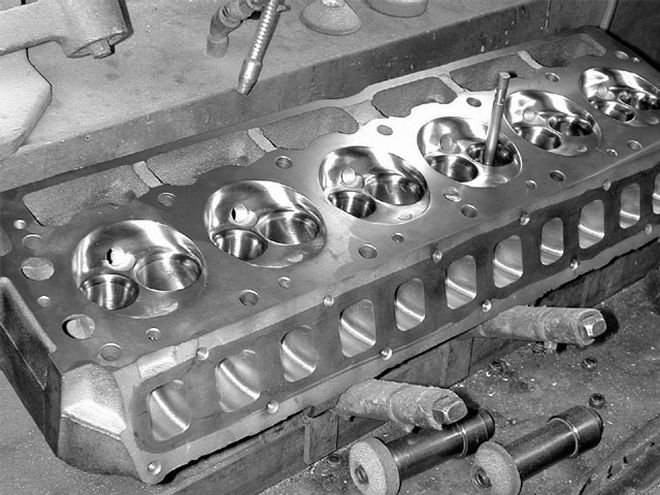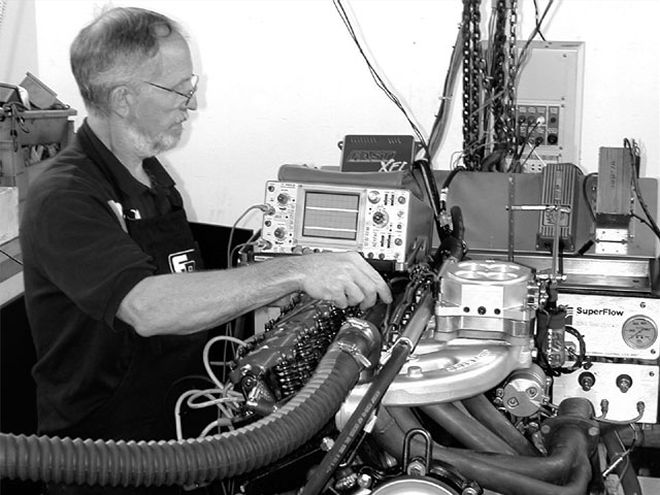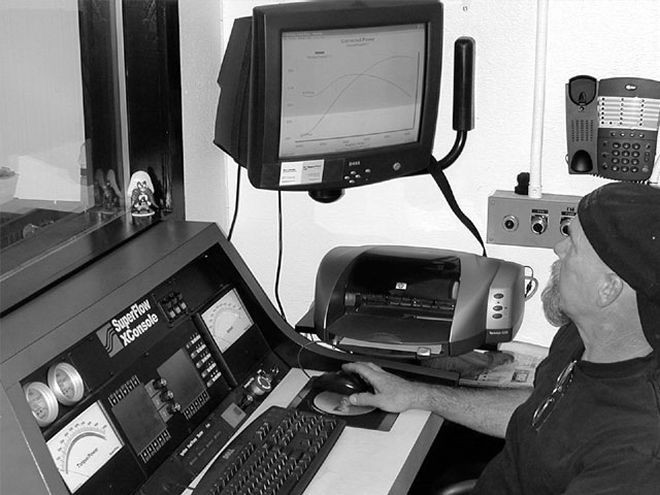
 For some reason, guys keep building these little six-cylinder engines for their daily drivers and even for their race cars. And why not, when they can produce decent power and open the envelope to what is regarded as normal. Just wait, their day of respect is near.
For some reason, guys keep building these little six-cylinder engines for their daily drivers and even for their race cars. And why not, when they can produce decent power and open the envelope to what is regarded as normal. Just wait, their day of respect is near.
Chrysler's potent little Slant Six definitely gets no respect! Sure, one of them shows up every now and then, but how many of us have thought about building one for racing? If you do, and want a better e.t, you could always bolt on a supercharger or nitrous, but what's the little beast capable of doing in normally aspirated dress? We know you're saying, what's the point, it's still a six-cylinder? The first strike against it is the rotating assembly is known to be rugged, but heavy, limiting rpm. And that intake manifold . . . . If you were a group of air/fuel molecules you wouldn't like making those sharp turns at the base of the carburetor, and then that long run to the cylinder head. Also, no two runners are the same length, and fuel puddling is common. Then there's that cylinder head-beefy, but not exactly free flowing.
Some guys really enjoy racing their Slant Sixes, and we were curious about what more could be done to one. When Romeo Furio started chatting with Mopar Engines West (MEW), the discussion yielded blank looks from the engine builders. Why would anyone build a normally aspirated Slant Six for racing? Since Romeo is a starch proponent of Slant Six racing, he sent MEW a 225 engine for dissection. The base engine for the build was a mess, and soon it became obvious there are some inherent limitations.
Compress It
The basic Slant Six has always done well with its 7.5:1 compression ratio. But the good news is the head has so much material in it that whacking off 11/410 inch or so from the surface would be possible (We're not kidding). The math said with a flat-top piston, this combination could yield about a 13.0:1 compression ratio by shaving the heads surface and removing about five pounds of cast iron.
The Rods And Slugs
The Slant Six has a long-standing reputation as being virtually indestructible. One reason for this is the pistons, which have such tall skirts they actually look like beer cans. Slugs would be a better name than pistons. Sure you can have a lighter custom piston made, but it would still be a slug because of where the wrist pin is located in order to use a stock rod. The block's deck height and the rod length fix the compression distance. We got to thinking, what if we spring for a set of custom rods, would the change be worth anything?
One Big Head
What can you say other than it's heavy? No one makes an aftermarket head, so we'll have to make do the best we can. Angie at Mopar Engines West does all the head work in the shop, and maybe she can squeeze some flow out of this boat anchor. It's going to take quite a bit of time with the grinder, but we'll give it a try.
The Intake Manifold
Fuel distribution is a problem for any race engine, but the Slant Six pushes the limit with this issue. Don't consider using EFI for improved power alone. A well-tuned carburetor will make as much power as EFI. Port-injected EFI will make a little more power because manifold fuel-distribution problems go away, but since most race manifolds are already good, there's not much to gain. Usually, we are talking about a V-8 or a Hemi engine, but the Slant Six might be an exception. The Slant Six's fuel distribution is so bad in stock form, that we wondered how much more power was actually on tap if they switched it over to a port-injected F.A.S.T. EFI system. To find out, we figured we could make a few pulls on the dyno with a carburetor, and then switch to EFI while it's still bolted fast. Nobody has ever done that before.
The Short-Block
There are two crankshafts that were used in the Slant Six. A forged unit was used from the '60s and into the '80s, but then a lighter cast crankshaft was used. The key word here is lighter. We figured the cast crank would be plenty strong enough to handle the power we were after, so a cast crankshaft it is. This is normally 180 degrees from what anyone would normally do when considering a race engine, but again, a cast crank should be adequate for the anticipated power level. The cast crankshaft also has narrower rod journals. This will also help the power level by using narrower bearings thereby reducing friction.
Since we decided to use a custom connecting rod already, we will use a custom forged piston, as well. We want to minimize the piston's skirt length by shortening the compression distance. Also, we might as well use a smaller wrist pin. When the piston decision was made, we then knew what longer custom aluminum rods were needed to match them. But now we are creating problems for ourselves because the bore size on a 225 Slant Six is so small (3.4-inches) that the rods are most likely going to hit the bottom of the cylinder bores. Aluminum rods make this even worse because they are usually much wider at the big end. The solution we came up with is a tad expensive, but we figured we could cut the crankshaft, making the rod journal sizes smaller. Now we could make the outside dimension of the big end of the rod smaller. While we're at it, it also allows us to offset grind the journals to gain a little added stroke. After all, nobody makes a stroker crankshaft for a Slant Six.
Mopar Engines West decided not to deck the block as much as they could have in order to preserve the deck's strength and leave room for future rebuilds. So the block's deck height ended up at 10.67 inches. The new compression height yielded a nice short piston, but not so short as to put the pin bore in the oil ring. The rod journals were undersized slightly to allow for aluminum rods, and the head was cut significantly, yielding a 44cc chamber.
When all the math was done, the piston resides .020 inch down in the hole to allow for rod stretch since we are using aluminum rods. A steel head gasket was used, and the result is a 234-inch Slant Six with a 13.25:1 compression ratio using a flat-top piston and a 44cc chamber. What is not shown by any of the pictures is the weight savings of more than 100 grams per cylinder that was achieved. This will not affect the horsepower much, but it did allow the engine to rev quickly and go well beyond the typical 6,000-rpm limit of the Slant Six. The engine was singing happily at more than 6,500 rpm. The smaller journal size allows the use of 283 small-block Chevy bearings. This is important, because with aluminum rods you must use a dowel pin, and heavy-duty bearings for a 283 Chevy are easy to get. The wrist pin is also small-block Chevy measuring .927-inch. The piston rings are 1.5/1.5/4.0mm pieces used in the Honda Vtech engine. The rod bearings are Calico's coated CB745HD. The bearings are narrowed .040 inch on each side, chamfered, and coated with their CT-1 coating.
The short-block assembly did require some special attention. The main bearings are coated Calico bearings 4M1419AL. Clearances were checked, and the crank was test fit in the block. A piston-and-rod assembly was then installed to see how close the connecting rods would come to the bottom of the cylinder bores during their rotation, and to check the deck height. This was when we found out how much the bores needed to be notched. We had already minimized the amount of notching required by making the rod end as small in diameter as possible. Notching the bores can be a touch-and-go process, because there's a cooling water passage close to the area needing clearanced. So after the rotating assembly stopped hitting everything, the crank was permanently installed. By the way, have your ever bought a rear main seal for your V-8 engine and wondered what those extra little angled pieces are for? Well, they are for a Slant Six. It turns out that the rear main seal for a big block and a Hemi is the same as the Slant Six.
Not only is the rear main seal the same, but the crankshaft snout is also the same as a big-block. So finding a high-performance SFI balancer took no more time than getting a 440 balancer. Of course, the timing marks on a big-block balancer are in a different place from that of a Slant Six, but we just made a new timing mark on the timing cover.
Now the block is ready for the cam and timing set. The double roller timing set and the camshaft came from Clifford. The cam is a solid flat-tappet cam (PN 310 with mechanical lifters), and its specifications are: 270-degrees duration at .050-inch lift, and .569-inch lift, with a 108-degree lobe separation. The cam was installed at 104-degrees intake centerline. After the rod and main bearings are torqued, and the cam is in, the bottom end can be buttoned up.
 Angie at MEW does all the head porting. A lot of time went into getting this head to flow with these numbers: 200 cfm at .600 inch on the intake side, and 150 cfm at .600-inch exhaust side. The valves are from a small-block Chevy, with ISKY PN 6005 springs. This should hold things stable up to 7,000 rpm.
Angie at MEW does all the head porting. A lot of time went into getting this head to flow with these numbers: 200 cfm at .600 inch on the intake side, and 150 cfm at .600-inch exhaust side. The valves are from a small-block Chevy, with ISKY PN 6005 springs. This should hold things stable up to 7,000 rpm.
Now we get to the good/bad part, depending on how you look at it-the head. Angie at MEW installed small-block Chevy valves with ISKY PN 6005 springs. These should hold things stable up to 7,000 rpm. Next, Angie spent some time porting, and finally ended up with flow numbers of 200 cfm at .600 inch on the intake side, and 150 cfm at .600-inch exhaust side. The head was installed using ARP studs and a .020-inch-thick steel head gasket sprayed with Hylomar. Piston-to-valve clearance checked out OK, thanks to JE designing valve reliefs in the pistons. The rocker arm system has to be able to keep up with the rest of the engine, so a custom set of roller rocker arms were purchased from Cox Brothers in Columbus, Ohio. We then found out the extra rocker arm ratio moved the pushrods closer to the block, requiring the engine be disassembled so pushrod clearance could be made. Once MEW made sure nothing was interfering with anything else, the engine was buttoned up. Finally, a water pump, a stock-style distributor with a Pertronix conversion, and a high-volume oil pump was installed, and it was off to the dyno for testing with Romeo's race carburetor and exhaust. It was quickly noted that the carburetor was running lean on the top end, but after breaking in the cam and optimizing the timing, we were pleased with 300 horses and an engine that would easily spin past 6,000 rpm.
Once the XFI system was installed, the engine was restarted and warmed up. We dialed in the XFI box, and then checked the valve lash to ensure nothing had changed. An oscilloscope was used to check the fuel injector sequencing, as well as crank reference timing, and all was good.
 Before the engine could be fired up with the EFI, we test to make sure the injectors are firing properly and in sequence.
Before the engine could be fired up with the EFI, we test to make sure the injectors are firing properly and in sequence.
Spitting the fuel into the newly machined manifold are 36 lb/hr injectors from F.A.S.T., along with a 1,000-cfm throttle body from MSD. Of course, now there are sensors to connect: water temp, air temp, MAP (manifold vacuum), TPS (throttle position), IAC (idle air control) and a bung had to be welded in the exhaust for the wide band O2 sensor. The distributor also had to be modified to generate the crank signal and not mess up rotor phasing.
So was EFI worth all the work? Did the direct port injection make up for a rather poor intake manifold design? Check out the graph (Diagram 1), and decide for yourself. In this application, the poor design of the Slant Six's intake was overcome by placing the fuel supply directly in front of each intake port.
 when we finished pulling the little Slant Six to its full rpm, we did get more horsepower with the EFI setup-quite a bit actually. How does 320 at 6,000 rpm sound? Even torque was up to 303 lb-ft at 5,000 rpm.
when we finished pulling the little Slant Six to its full rpm, we did get more horsepower with the EFI setup-quite a bit actually. How does 320 at 6,000 rpm sound? Even torque was up to 303 lb-ft at 5,000 rpm.
Ok, so it's not a Hemi, but it is cool in its own way. While doing the math on the computer, theoretically, 1-hp-per-cubic-inch should be easy, but we were thinking more 1.25-hp-per-cubic-inch. So a 225 Slant Six should be capable of 300 horses. We were happy that we surpassed our goal, and Romeo was ready to place the little Big-Bullet in his Dart.